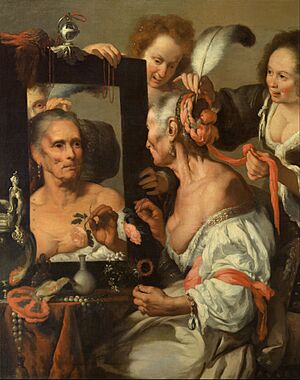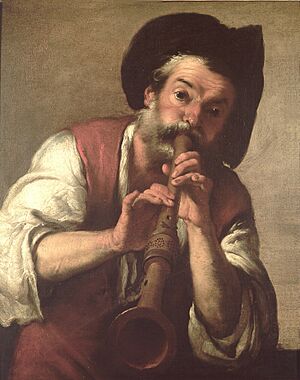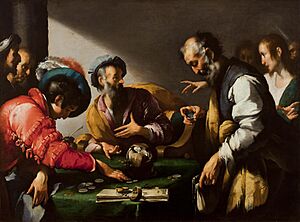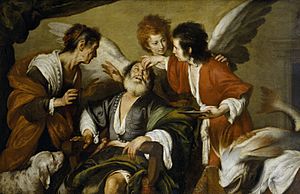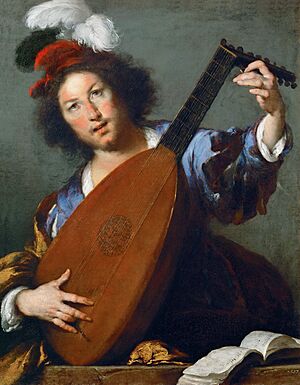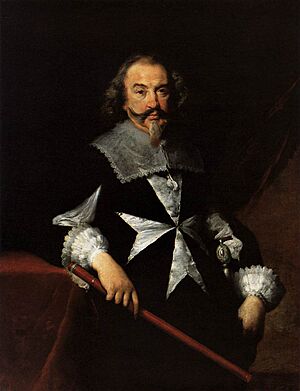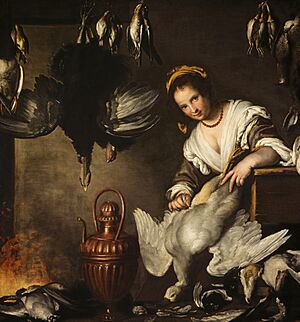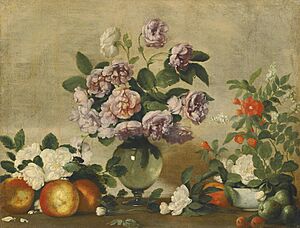Bernardo Strozzi facts for kids
Bernardo Strozzi (born around 1581 – died August 2, 1644) was a famous Italian painter and engraver from the Baroque period. He was also known as il Cappuccino (the Capuchin) and il Prete Genovese (the Genoese Priest). Strozzi painted many different things, including historical scenes, allegories (pictures with hidden meanings), everyday life scenes, and portraits. He also painted still lifes. He started his career in Genoa and later moved to Venice. His art greatly influenced painters in both cities. He is seen as one key artist who helped create the Venetian Baroque style. His paintings are known for their rich, bright colors and bold, energetic brushstrokes.
Contents
Life of Bernardo Strozzi
Bernardo Strozzi was born in Genoa. He began his art training with Cesare Corte, a Genoese painter. Later, he joined the workshop of Pietro Sorri, who helped Strozzi move towards a more natural style of painting.
In 1598, when he was 17, Strozzi joined a Capuchin monastery. This was a religious group that was part of the Franciscan order. During his time there, he likely painted many religious pictures. These often showed scenes from the life of Saint Francis, who inspired the Capuchin order. Because he was a friar in the Capuchin monastery, people called him "il Cappuccino." He was also allowed to dress as a priest, so he was known as "il prete genovese."
Around 1608, Strozzi's father passed away. Strozzi then left the monastery to take care of his mother and unmarried sister. He earned money for his family by painting. His career really took off in the next ten years. Powerful families in Genoa, like the Doria and Centurione families, became his supporters.
Strozzi received important jobs to paint large wall decorations, called frescoes. His most important frescoes were in the San Domenico church. These were ordered by the Doria family. Sadly, most of this work is now destroyed. We only know about it from a small oil sketch for the ceiling. It is thought that Strozzi visited Rome for a few months in 1625.
Around 1625, Strozzi's relationship with the Capuchin order became difficult. The order was unhappy with him for reasons that are not fully clear today. Some people believe it was because he was painting outside the monastery. His Capuchin leaders did not like his portraits and paintings of everyday life.
The problem became very serious in 1630. Strozzi refused to return to the monastery after his mother died and his sister got married. His superiors then had him held for about 17 or 18 months.
By 1632 or 1633, Strozzi had moved to Venice. He was allowed to work and live there. Within two years, Strozzi became very well-known, even though he was not from Venice. He slowly became recognized as one of the top artists of his time. The Doge (leader) of Venice, Francesco Erizzo, became one of his most important supporters. Strozzi likely painted the Doge's portrait soon after arriving in Venice.
Other important people who supported him included Cardinal Federico Cornaro and members of the Grimani family. Famous Venetian artists like the musicians Claudio Monteverdi and Barbara Strozzi also supported him. The poet Giulio Strozzi was another supporter. It's not clear if the Strozzi families were closely related.
The artist worked on important public projects. He painted altarpieces (paintings for altars) in churches like the Chiesa degli Incurabili. He also painted a round picture called an Allegory of Sculpture for the Biblioteca Marciana library. Strozzi was given the special title "Monsignor," but people still usually called him "il prete genovese."
Strozzi had many students and produced a large number of paintings. Many of his works exist in several versions. This shows that he had several assistants and a big workshop. Some of his known students were Francesco Durello and Giovanni Andrea de Ferrari.
Towards the end of his life, he also worked as an engineer. Bernardo Strozzi passed away in Venice in 1644.
Bernardo Strozzi's Artworks
General Style of Strozzi's Art
Bernardo Strozzi was a very active artist who painted on canvas and created frescoes. He painted many different subjects. These included historical events, allegories (pictures with symbolic meanings), scenes from everyday life, and portraits. He also painted still lifes, and many of his paintings include elements of still life. Most of his works are religious paintings.
While he also painted frescoes, he was more successful with his canvas paintings. Many of his paintings exist in multiple copies made by Strozzi himself. This was a common practice for artists at that time.
How Strozzi's Style Changed
Strozzi's painting style kept changing throughout his career. His early art was inspired by the many different styles in Genoa around the year 1600. He started with a style that was elegant but a bit artificial, like the late Mannerist style. He then slowly moved towards a more natural way of painting.
Early on, Strozzi learned the Mannerist style from his teacher Sorri. This style often showed figures that were long and curved. Their fingers were thin, their heads tilted, and their clothes had abstract patterns. In the 1620s, Strozzi began to move away from Mannerism. He developed his own style, which was more natural. This new style was influenced by the artist Caravaggio and his followers.
Caravaggio's style came to Genoa through other painters. Strozzi's painting Calling of St Matthew (around 1620) looks very similar to Caravaggio's work. However, it still has some Mannerist features.
Strozzi also saw the work of Anthony van Dyck and Peter Paul Rubens. These Flemish artists lived or visited Genoa. Their work helped Strozzi paint more naturally and completely move away from Mannerism. His colors became warmer, and he used bolder, more visible brushstrokes. In his painting St. Lawrence Distributing the Riches of the Church (around 1625), he used light and shadow to make the space clear. The paint in this work was applied very thickly, a technique called impasto.
By the late 1620s, Strozzi had created his own unique style. It combined the painting styles of Northern Europe (like Rubens) with a strong, realistic look. When he moved to Venice, his paintings became softer. This style was more popular with local art buyers. It was also influenced by other artists in Venice, like Jan Lys. Strozzi was inspired by Veronese to use brighter and more colorful paints. An example is his Parable of the Wedding Guests (1636). His style also continued to show the strong influence of Rubens. This can be seen in his Allegorical figure (Minerva?) (mid-1630s). This painting combines Rubens' strong shapes and bright colors with the warm feeling of Venetian art.
His most recent works are bright and look like sketches. Examples include David with the Head of Goliath (after 1640) and Rebecca and Eliezer at the Well (after 1630). His Lute Player (after 1640) has a poetic mood. This feeling likely came from his study of Giorgione's work.
Strozzi's Portraits
Strozzi was a popular portrait painter. He painted important noble people, church leaders, and artists of his time. In the late 1630s, he was asked to paint a series of portraits of the famous Raggi family in Genoa. Other artists like Antony van Dyck also worked on this project. About 14 portraits from this series still exist. Even though different artists painted them, the portraits look similar in their arrangement. This was based on van Dyck's ideas. Strozzi painted more portraits for this series than any other artist. This might mean he had a special connection with the family who ordered the paintings.
Strozzi's Genre Paintings
Strozzi was probably inspired by Flemish (Dutch and Belgian) paintings of everyday life. He also learned from Caravaggio's style to create his own genre works. Genre paintings show scenes from ordinary life.
His most famous genre painting is The Cook. Many versions of this painting exist (around 1625 and 1630–40). This work was influenced by Pieter Aertsen's The Cook (1559) and the work of Jan Roos. These paintings show daily life without any hidden meanings.
His lively painting The flute player also exists in several copies. This is another genre painting that shows how much he learned from Flemish art. This includes the subject, colors, and painting style. Strozzi used colored shadows, which he learned from Rubens. However, Strozzi painted on a reddish-brown background, using light brushstrokes in paler colors.
Strozzi's Still Lifes
Bernardo Strozzi's work as a still-life painter is not fully understood yet. There is still some confusion about how his art developed in this area. We know that he painted still lifes throughout his career. He also included still-life elements in many of his other paintings. An example is the still life of game (hunted animals) in his work The Cook.
The Still life with flowers in a glass vase and fruits on a ledge is one of the few still lifes that is definitely considered to be by Strozzi. The design is simple, with most objects placed on a similar level. The painting reminds us of Caravaggio's Still life of fruits and flowers in a basket. This is because of the soft light coming from the left and the cream-colored background. As was his usual style, Strozzi applied the paint thickly throughout the painting.
Strozzi's Influence on Art
Bernardo Strozzi's work had a big impact on art in both Genoa and Venice. He is seen as a main founder of the Venetian Baroque style. Painters in Genoa who were strongly influenced by Strozzi include Giovanni Andrea de Ferrari and Giovanni Benedetto Castiglione. In Venice, artists like Ermanno Stroiffi and Francesco Maffei also showed Strozzi's influence in their works. He is also thought to have influenced the Spanish painter Murillo. Murillo may have known Strozzi's work, such as Veronica (1620-1625).
See also
 In Spanish: Bernardo Strozzi para niños
In Spanish: Bernardo Strozzi para niños


